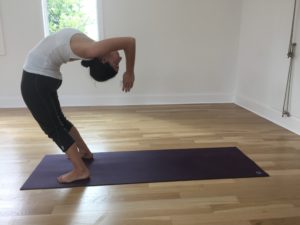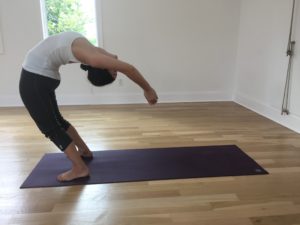by Nicole Horne
I always wanted the experience of practicing yoga during pregnancy. Partly because I rebel against any prescription that tells me under what circumstances and at what age I must stop being active. But also because of how deeply I knew I’d be able to feel the transformation happening in my body and mind.
Although practice during the first trimester was more sporadic than expected (or even hoped), I felt fortunate, for the knowledge I had gained during previous years of practice allowed me to stay connected to my body and listen closely in a way that wouldn’t have been likely, or even possible, otherwise.
Before I even knew I was pregnant, I had read about Ashtanga practice during pregnancy. I was disappointed to learn that women were normally encouraged to stop asana practice during the first trimester. Yet when it finally happened, and I approached Melanie with the news, I was pleased to hear a few basic recommendations and encouragement to trust the knowledge contained within my body. Cutting myself off from the physical practice, especially now, felt wrong.
Although during the first couple of weeks I was able to practice normally (excluding a few modifications, such as avoiding jump-throughs), even maintaining my five day a week routine, by week 7 my morning sickness (really an all-day queasiness that peaked early evening) set in. As most women who’ve experienced this will tell you, it is worse after not eating, which means it’s particularly bad upon waking. Part of my challenge was not only my dwindling energy (also courtesy of the first trimester), but also establishing a new routine that required more effort and planning than roll out of bed, get dressed, brush your teeth, head to the studio…
So I practiced when I could. Like, when I woke up early enough to have a small breakfast and give it time to settle, or when I got a lot of sleep the night before. Despite my fatigue and tendency to turn in early, this last one was not a given, as nightly trips to the bathroom began to disrupt my sleep and make waking up even more difficult than it already was. I went from practicing at least five days a week to two or three if I was lucky.
When I did make it to the studio, I softened. My principle concern was to not overexert and exhaust myself. So I planted my mat in a corner next to an open window and under a fan and moved slowly through the postures, breathing deeply and stopping when I began to feel too tired or hot or even a little nauseous. Sometimes, this meant stopping after finishing the standing sequence. Sometimes, this meant stopping after a single sun salutation.
Slowly, as my abdomen began to feel more crowded, I let go of the deep twists (uttita trikonasana B, uttita parsvokanasana B, marichyasana c & d, etc.), exchanging them for gentler modifications, and stopped lying on my stomach or doing anything that felt like it crunched the abdomen (arda baddha padangusthasana, kurmasana, supta kurmasana, salabasana, bhekasana, danurasana, etc.). It’s possible that I had (even have) room for these postures, but I was still in disbelief that I was pregnant and wanted to consciously send more awareness to that area of the body. Making these changes seemed like the natural and appropriate thing to do.
One part of the practice I’ve held on to are the backbends. I loved the way they felt before pregnancy and each time I practice, no matter how far along through the series I go, I save energy for the backbends. With the weight distribution in my body changing, it’s more difficult to fight the gravitational pull towards the earth. Backbends relieve a lot of the related tension and help me create space so that I keep sending the spine upwards rather than curve downward. One thing I am careful of, though, is any uncomfortable stretching that may pop up in the abdomen. This happens if I work especially quickly, so I make sure to slow down to and focus on bending from the top of the spine. Sometimes, this means I don’t go as deep as I once could, and that’s okay.
I’ve just begun the second trimester, and my most recent modification is widening the stance during forward folds, focusing on lengthening rather than deepening. It’s another part of my efforts to create space and generate a nurturing awareness in the low abdomen.
I thought I’d have more trouble letting go of the physical practice. But, as Melanie once told me, someone else in control now, and it’s been surprisingly easy to soften and just let the practice be. I think this is because, as most practitioners already know, the physical practice is always changing; even when we are in peak physical shape, each day is never the same. Acceptance of the ephemeral nature of all things is what we cultivate every day on our mats, and this makes me excited to feel the practice’s evolution, not just as the pregnancy progresses, but when I am a mother as well.
Stay tuned for second trimester updates and more thoughts on practicing during pregnancy.





Comments are closed.